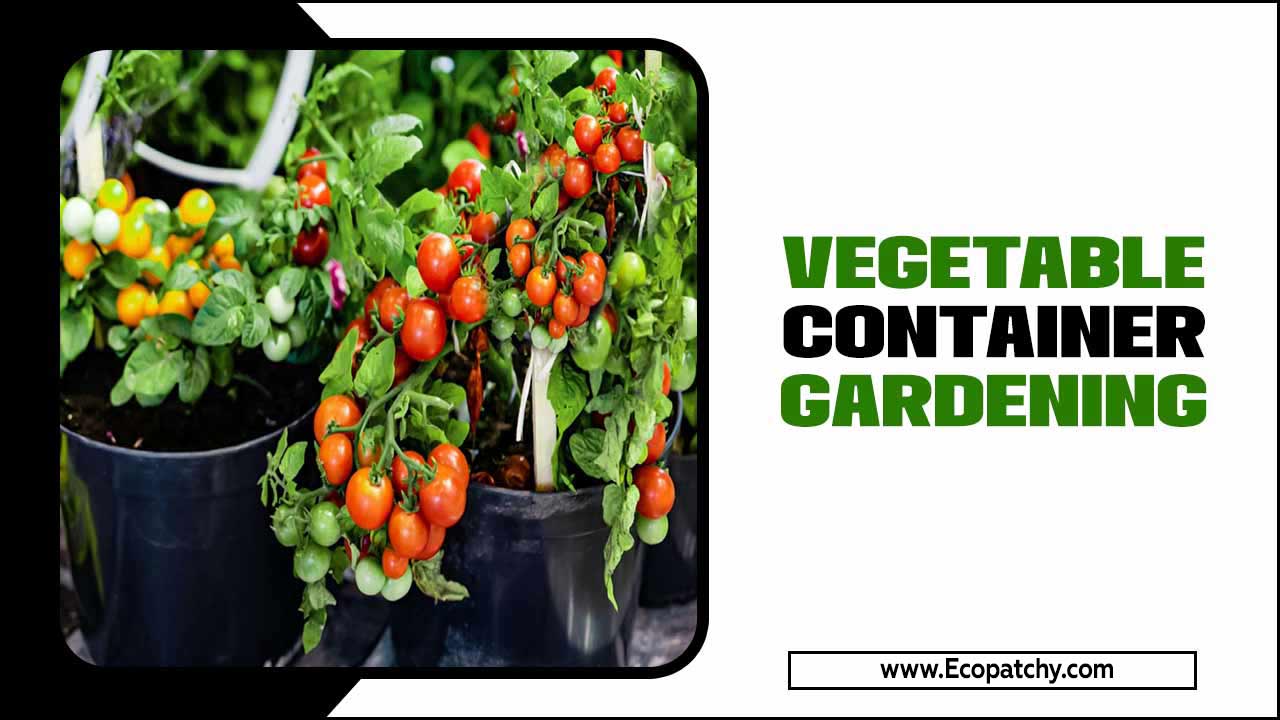Hostas are a popular choice for gardeners looking to add a touch of greenery and texture to their outdoor space. These versatile plants are known for their lush foliage and low maintenance needs, making them a favorite among beginners and experienced gardeners.
While hostas are traditionally planted in the ground, they can also thrive when grown in pots. Growing hostas in pots allow for more control over the plant’s environment and allow the opportunity to add a pop of color and style to any patio or balcony.
However, there are some important factors to consider when growing hostas in pots, such as the right type of container, soil, and care. Here, we will guide you through how to grow hostas in Pots, from choosing the right materials to caring for your plants throughout the year.
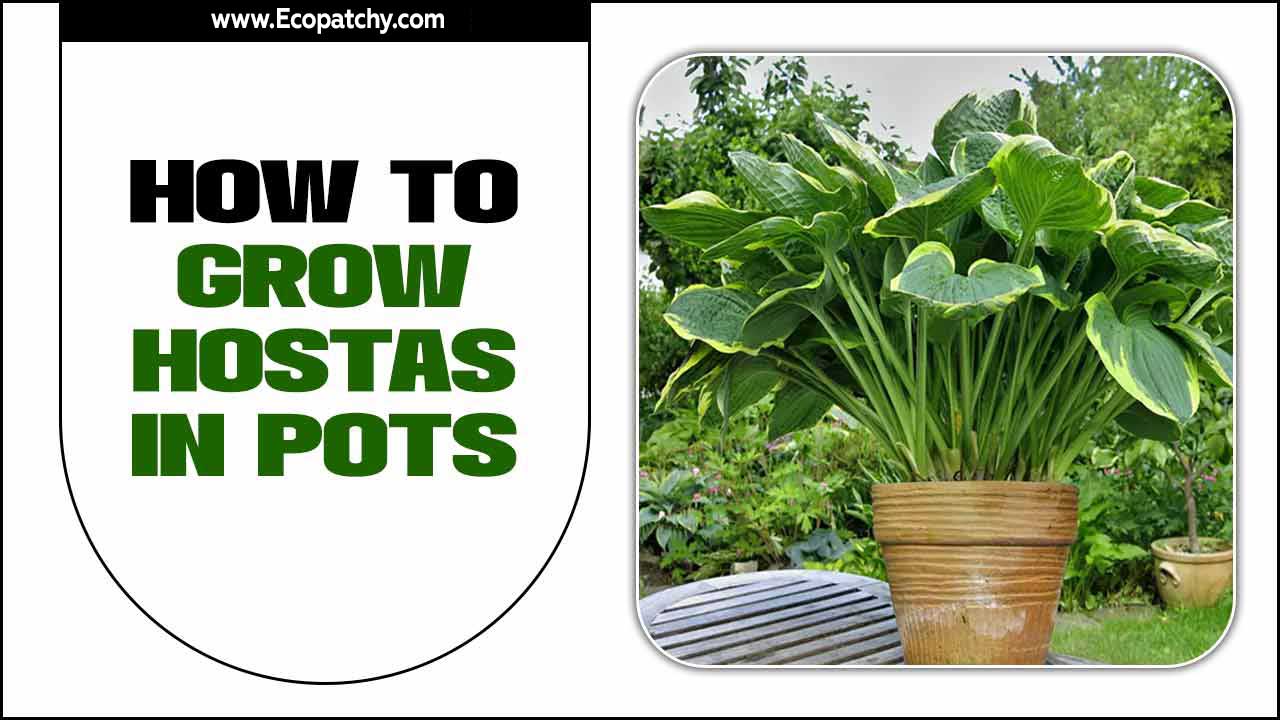
How To Grow Hostas In Pots – Full Discussion
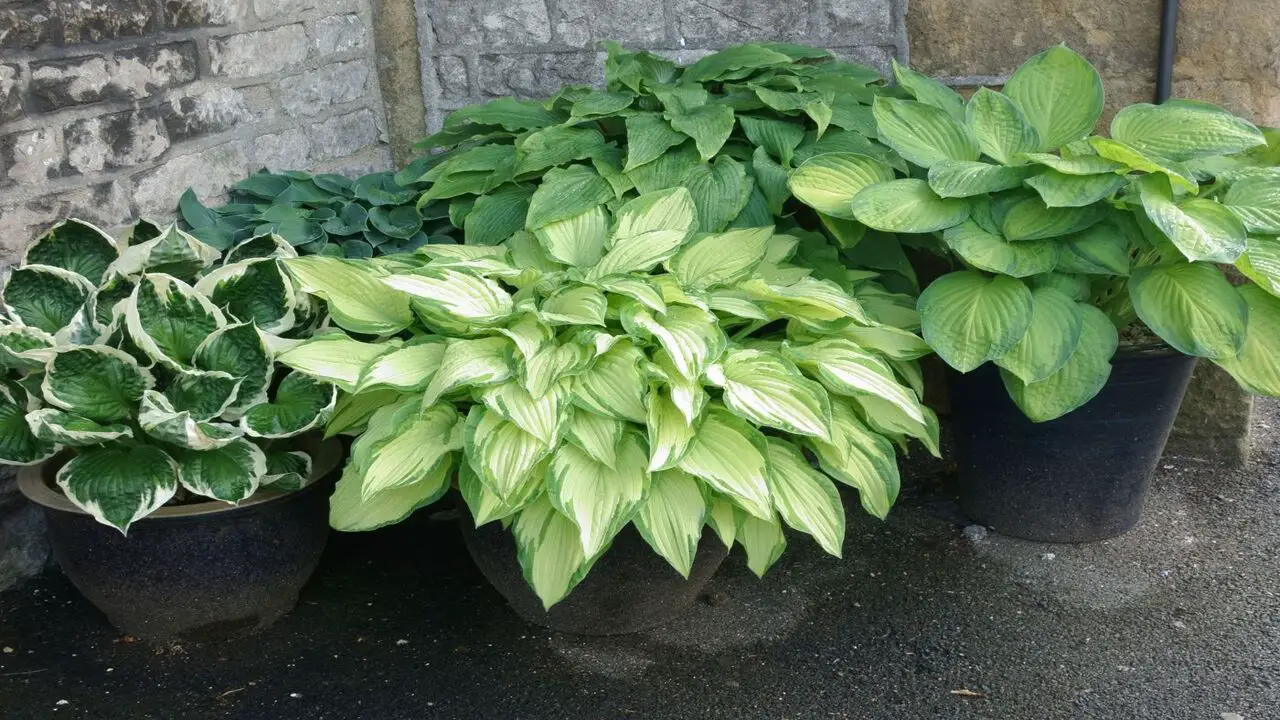
Here to know the answer on how to grow hostas in pots? Growing hostas in pots is a great way to add beauty and greenery to your outdoor space, especially if you have limited garden space or want to create a more controlled environment for these shade-loving plants. Here are some tips on how to successfully grow hostas in pots.
Firstly, choose a suitable pot for your hosta plant. Opt for a container at least 12 inches deep and wide, with good drainage holes to prevent waterlogging. Hostas have spreading root systems, so a wider pot will provide ample space for them to grow.
Next, prepare the potting mix. Hostas thrive in well-draining, nutrient-rich soil. Use a mixture of equal parts high-quality potting soil, compost, and perlite or vermiculite to ensure proper drainage and aeration for the roots.
When planting the hosta, ensure the crown is levelled with the soil surface. Firm the soil around the plant, but avoid compacting it too much.
What Are The Advantages Of Growing Hosts In Containers?
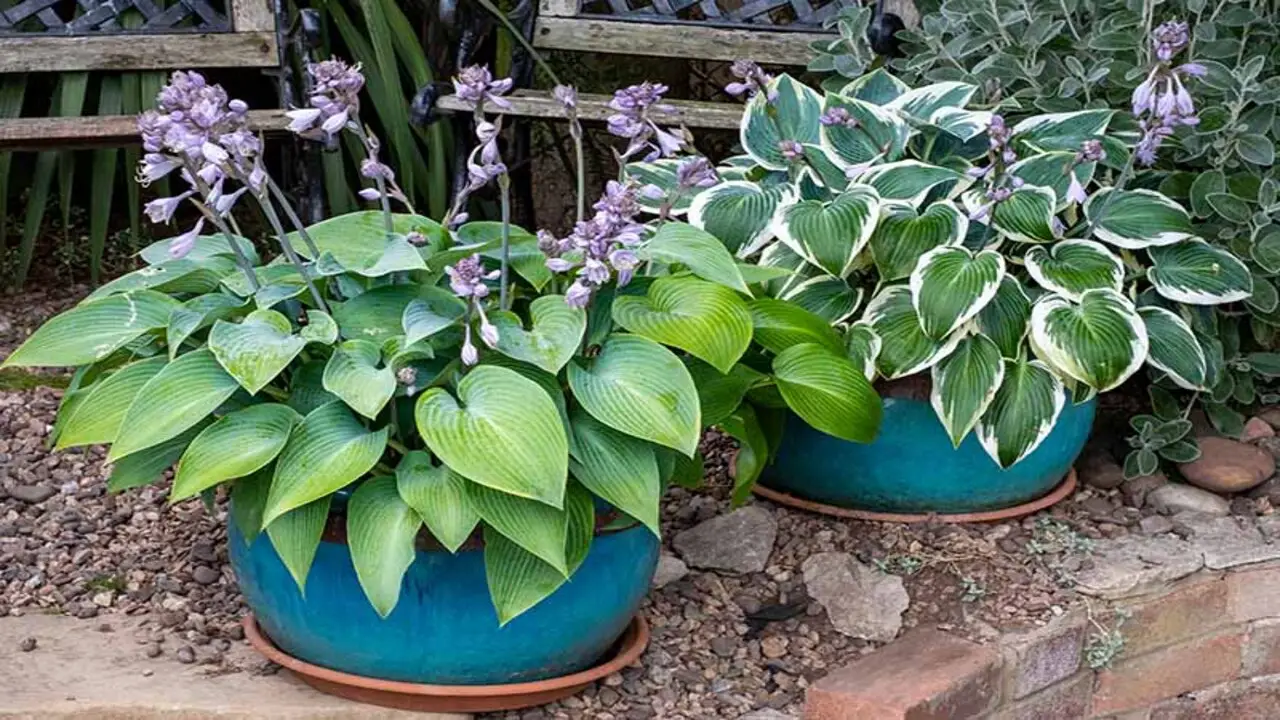
Additionally, growing hostas in containers provides more control over the growing conditions. Soil quality can be carefully selected and amended to suit the hostas’ preferences, ensuring optimal growth and health. There are several advantages to growing hostas in containers:
- Flexibility: Growing hostas in containers allows you to move them around your garden or patio, creating different arrangements and designs.
- Space-Saving: Growing container hostas can be a great solution if your garden has limited space. You can place them on balconies, terraces, or small areas where traditional gardening may not be possible.
- Pest And Disease Control: Container gardening helps minimize the risk of pests and diseases affecting hostas. It provides a controlled environment that is easier to monitor and treat if any issues arise.
- Soil Control: By growing hostas in containers, you have complete control over the soil composition. You can ensure the soil is well-draining and rich in organic matter, which is essential for the healthy growth of hostas.
- Protection: Containers provide some protection against extreme weather conditions. During harsh winters, you can move the containers indoors
Few Disadvantages To Planting In Pots
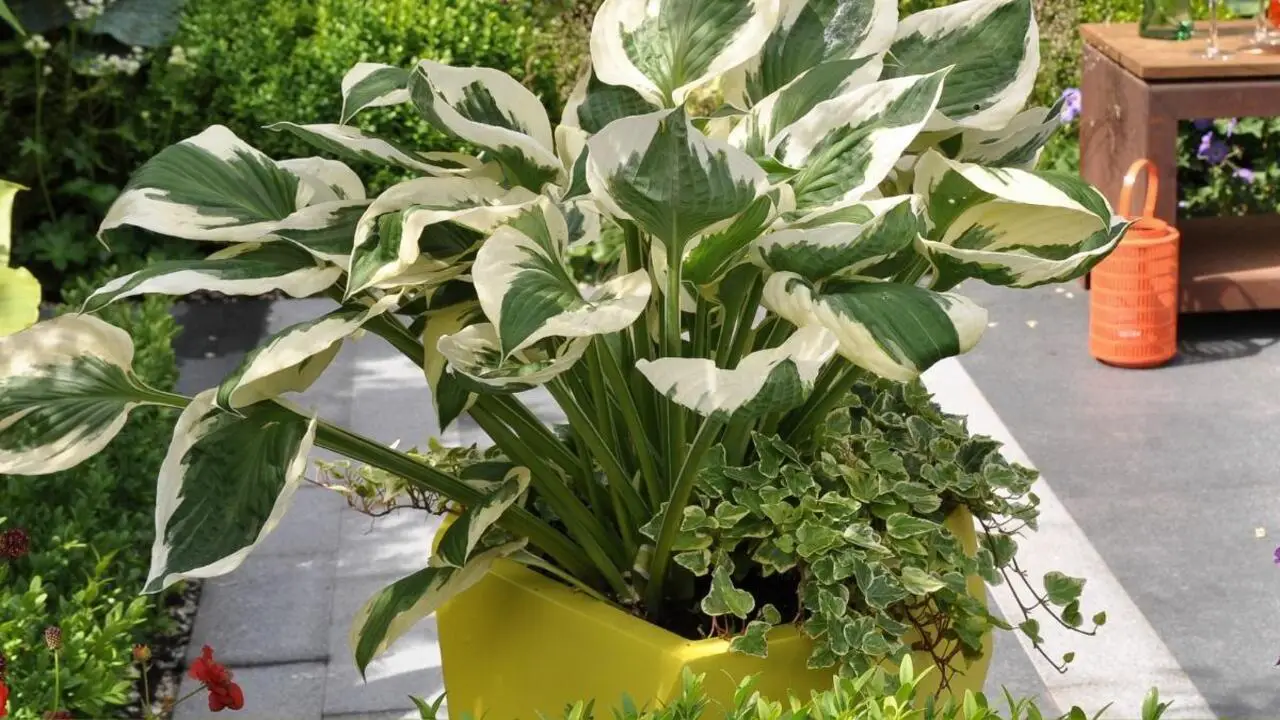
include the need for more frequent watering and the limited space for root growth. When growing hostas in pots, it’s important to remember that the soil in containers tends to dry out faster than in the ground. Regular watering is essential to prevent the plants from becoming stressed or wilting. Some disadvantages of planting in pots include:
- Limited Root Space: Pots have a finite amount of space for roots to grow, which can restrict plants’ overall growth and development compared to planting them directly in the ground.
- Moisture Management: Potted plants require more frequent watering as the soil in pots tends to dry out faster than in the ground. This can lead to increased maintenance and the risk of over or under-watering.
- Nutrient Limitations: Potted plants may have limited access to nutrients compared to those planted in the ground. Pot soil can deplete more quickly, requiring regular fertilization to ensure adequate plant nutrition.
- Temperature Sensitivity: Plants in pots are more susceptible to extreme temperatures as the soil in containers can heat up or cool down more rapidly than the ground. This can put stress on the plants and affect their overall health.
- Mobility restrictions: Pots are not as easily moved as plants in the ground.
What Size Pot Do I Need?
To grow hostas in pots, you will need a pot that is appropriate in size. Hostas have extensive root systems and require enough space for their roots to grow and spread. Generally, a pot with a diameter of at least 12 inches (30 cm) is recommended for a single hosta plant.
However, if you plan on growing multiple hostas in the same pot, you will need a larger container to accommodate their growing needs. Additionally, it is important to choose a pot with good drainage to prevent waterlogged soil, as hostas prefer moist but well-draining conditions.
What Type Of Pot Should I Use To Grow My Hosta?

To grow hostas in pots, choosing the right pot type is important. Hostas have extensive root systems, so it is recommended to use a pot that is at least 12-18 inches deep and wide. This will provide enough space for the roots to spread and grow.
When selecting a pot, ensure it has drainage holes at the bottom to prevent waterlogging, as hostas prefer well-draining soil. You can also consider using a pot with a saucer or tray to catch excess water.
A lightweight and durable material, such as plastic or fibreglass, is a good choice for hosta pots. These materials will retain moisture well and provide insulation for the roots during extreme temperatures.
Additionally, consider the color of the pot. Dark-coloured pots can absorb heat, which may cause the soil to dry out quickly in hot weather. Light-colored pots, on the other hand, reflect heat and help keep the soil temperature more stable.
What Kind Of Soil Should I Grow My Hosta Pot Plants In?
To grow hostas in pots, choosing the right pot type is important. Hostas have extensive root systems, so it is recommended to use a pot that is at least 12-18 inches deep and wide. This will provide enough space for the roots to spread and grow.
When selecting a pot, ensure it has drainage holes at the bottom to prevent waterlogging, as hostas prefer well-draining soil. You can also consider using a pot with a saucer or tray to catch excess water.
A lightweight and durable material, such as plastic or fibreglass, is a good choice for hosta pots. These materials will retain moisture well and provide insulation for the roots during extreme temperatures.
Additionally, consider the color of the pot. Dark-colored pots can absorb heat, which may cause the soil to dry out quickly in hot weather. Light-colored pots, on the other hand, reflect heat and help keep the soil temperature more stable.
What Type Of Light Should I Have For My Hosta?
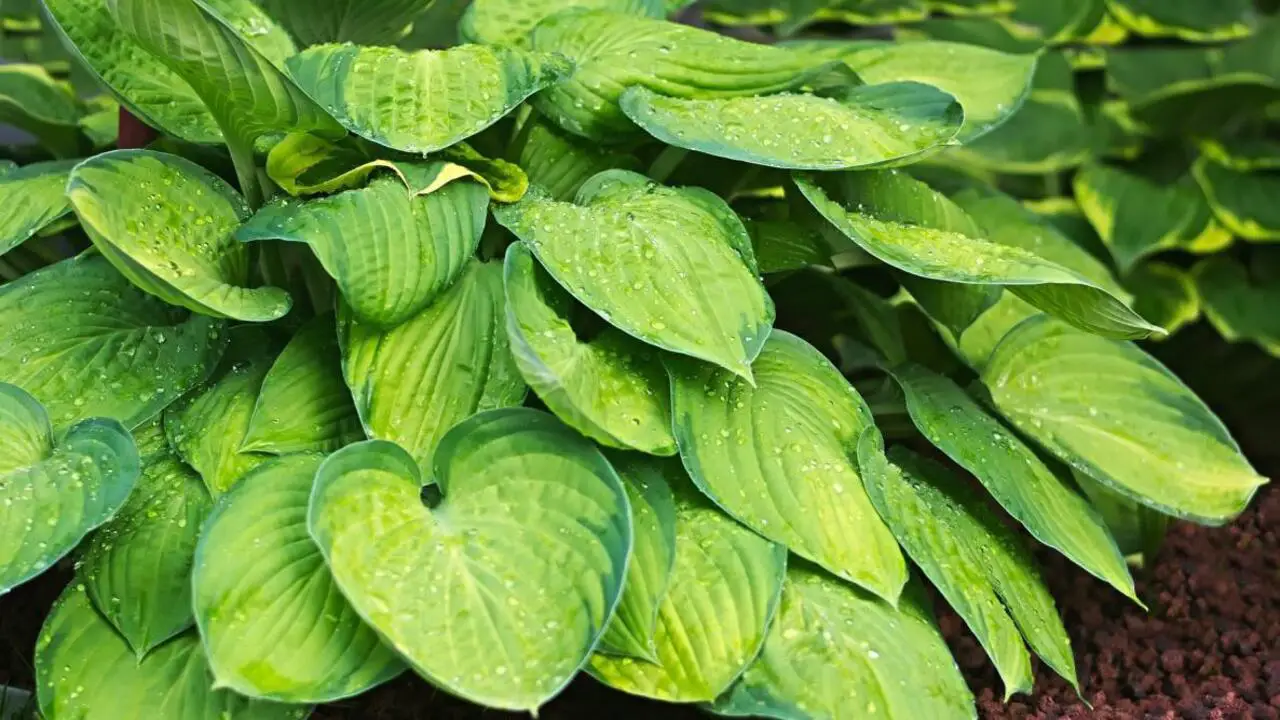
Hostas are shade-loving plants, so providing them with the right light is important. When growing hostas in pots, placing them in an area that receives filtered or indirect sunlight is recommended. This means placing them in an area protected from direct sunlight, such as under a tree or in a spot that receives dappled shade throughout the day.
Hostas prefer bright, but not intense, light. Too much direct sunlight can cause their leaves to burn or wilt. On the other hand, insufficient light can result in leggy and weak growth. Finding a balance and providing them with enough light to thrive is important.
If you are growing hostas indoors, placing them near a north-facing window or providing them with artificial light, such as fluorescent or LED grow lights, can help simulate their ideal lighting conditions. Remember to monitor your hostas closely and observe how they respond to the light conditions provided.
How Often Should I Water My Hosta Pot Plants?
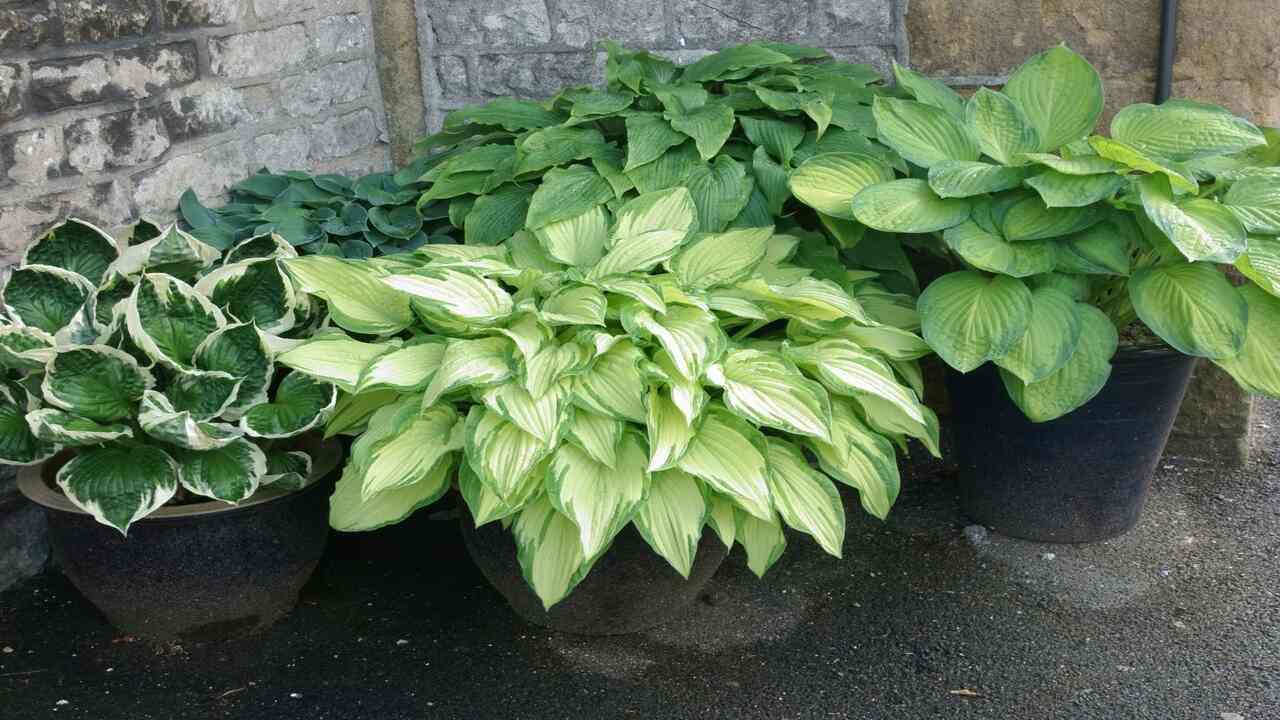
Hostas in pots require regular watering to thrive. The watering frequency will depend on various factors, such as the size of the pot, the weather conditions, and the moisture retention capacity of the potting soil. As a general guideline, it is recommended to water hostas in pots when the top inch of the soil feels dry to the touch.
However, it is important to avoid overwatering, as this can lead to root rot. To ensure proper hydration, monitor the soil’s moisture levels regularly and adjust the watering schedule accordingly.
How Deep Should I Plant My New Hosta?
To ensure the optimal growth of your new hosta plant in a pot, it is important to consider the depth at which you should plant it. When planting hostas in pots, digging a hole approximately twice the depth of the plant’s root ball is recommended. This will allow enough space for the roots to spread out and establish themselves properly.
After digging the hole, gently place the hosta plant into it, ensuring its crown (where the leaves emerge) is level with the soil surface. Backfill the hole with a well-draining potting mix, lightly firming the soil around the plant.
It is important to remember that hostas prefer consistently moist soil, so water the plant regularly, providing enough moisture to thrive. Additionally, ensure the pot has drainage holes to prevent waterlogging, as excessive moisture can lead to root rot.
What Are Some Hostas Suitable To Grow In Containers?
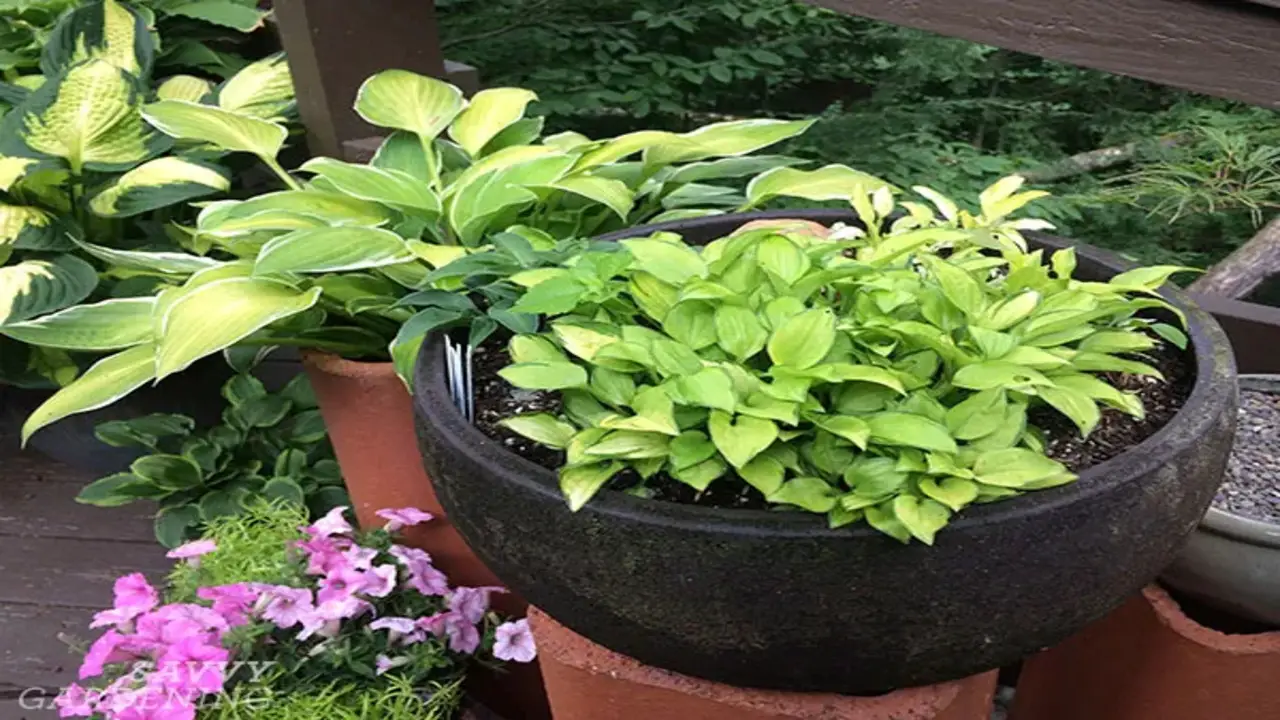
Several varieties are suitable and can thrive in pots. One of the first considerations when growing hostas in pots is choosing the right variety. While hostas are typically known for their large, lush foliage, not all varieties are suitable for container gardening. Fortunately, several compact and dwarf hosta varieties are well-suited for pot growth. Here are some hostas that are well-suited for container gardening:
- ‘Blue Mouse Ears’: This small-sized hosta has unique round leaves that resemble mouse ears. It grows about 6-8 inches tall and is perfect for smaller containers.
- ‘Golden Tiara’: With its vibrant golden foliage, this hosta adds color to any container garden. It grows to about 10-12 inches and prefers partial shade.
- ‘June’: Known for its striking variegated leaves, ‘June’ hosta is a popular choice for container gardening. It grows to 18 inches in height and thrives from partial to full shade.
- ‘Patriot’: This hosta variety features deep green leaves with crisp white margins, making it an eye-catching addition to a container garden.
How Do I Care For My Potted Hosta During Winter?
To care for your potted hosta during winter, it is important to take a few extra steps to protect the plant from the harsh weather conditions. First, choose a sheltered location for your pot, such as a covered porch or a garage. This will help shield the hosta from strong winds and freezing temperatures.
Next, consider insulating the pot by wrapping it with bubble wrap or hessian cloth. This will provide an extra layer of protection against frost. here are some important steps to follow:
- Location: Choose a suitable location for your potted hosta during winter. Ideally, place it in an unheated garage, basement, or any cool, dark area where the temperature remains consistently above freezing.
- Watering: Reduce watering frequency during winter, as hostas require less moisture in dormancy. Water the plant only when the soil feels dry to the touch, ensuring that the water drains well and doesn’t sit in the pot.
- Insulation: Provide insulation around the pot to protect the roots from freezing temperatures. You can wrap the pot with bubble wrap or burlap or place it in a larger container filled with insulating material like straw or leaves.
- Light: Hostas are shade-loving plants that don’t require much light during winter.
Can I Divide My Container Grown Hostas?
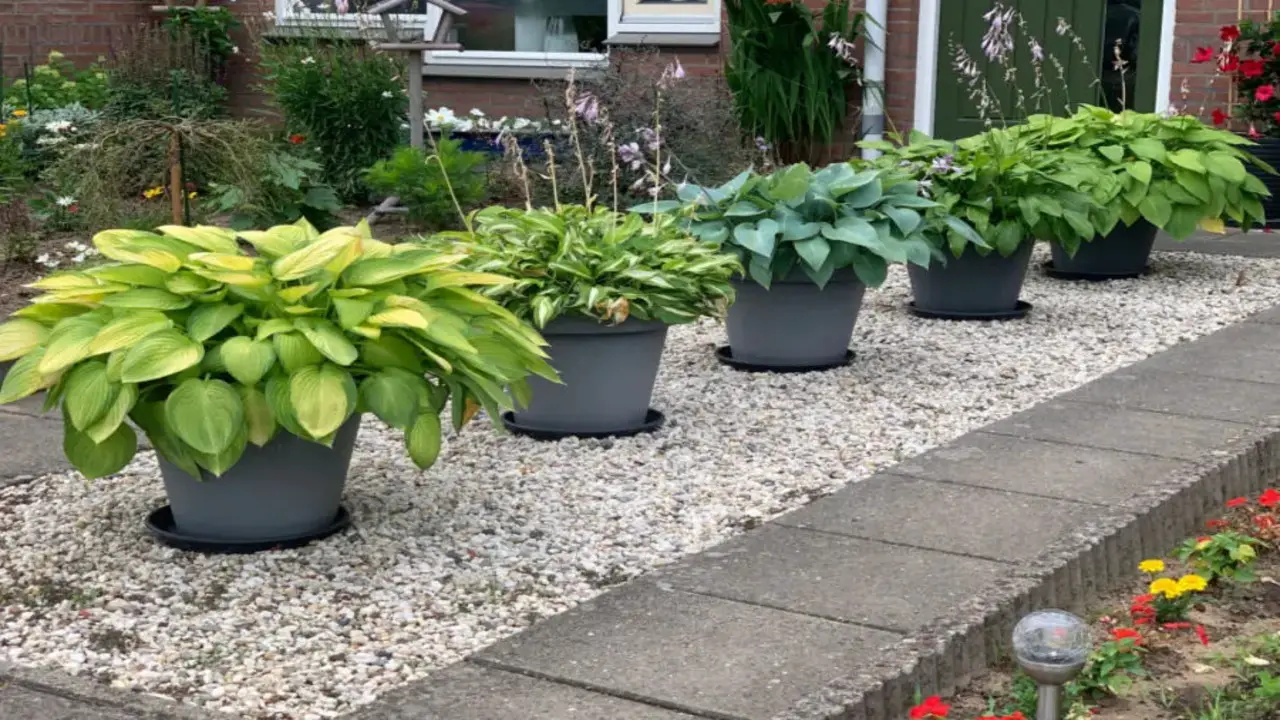
Yes, you can divide your container-grown hostas. Dividing hostas in pots is a great way to multiply your plants and ensure their continued health and vigour. The ideal time to divide hostas is when new growth emerges in early spring. Start by carefully lifting the hosta clump out of its pot, not damaging the roots. Gently shake off excess soil to expose the rhizomes and identify suitable divisions. Here’s some information on how to do it:
- Choose The Right Time: The best time to divide hostas is in early spring or late summer/early fall when the weather is mild.
- Prepare The New Containers: To accommodate the divided hostas, select new containers slightly larger than the current ones. Make sure the new containers have drainage holes.
- Water The Hostas: Before dividing, water them thoroughly to make removing them from the containers easier.
- Remove The Hostas From The Containers: Gently tap the sides of the containers to loosen the root ball. Carefully remove the hostas from the containers, trying not to damage the roots.
- Divide The Hostas: Using a sharp knife or garden spade, divide the hostas into smaller clumps. Each clump should have a good amount of foliage and healthy roots.
Maintaining And Pruning Hostas In Pots
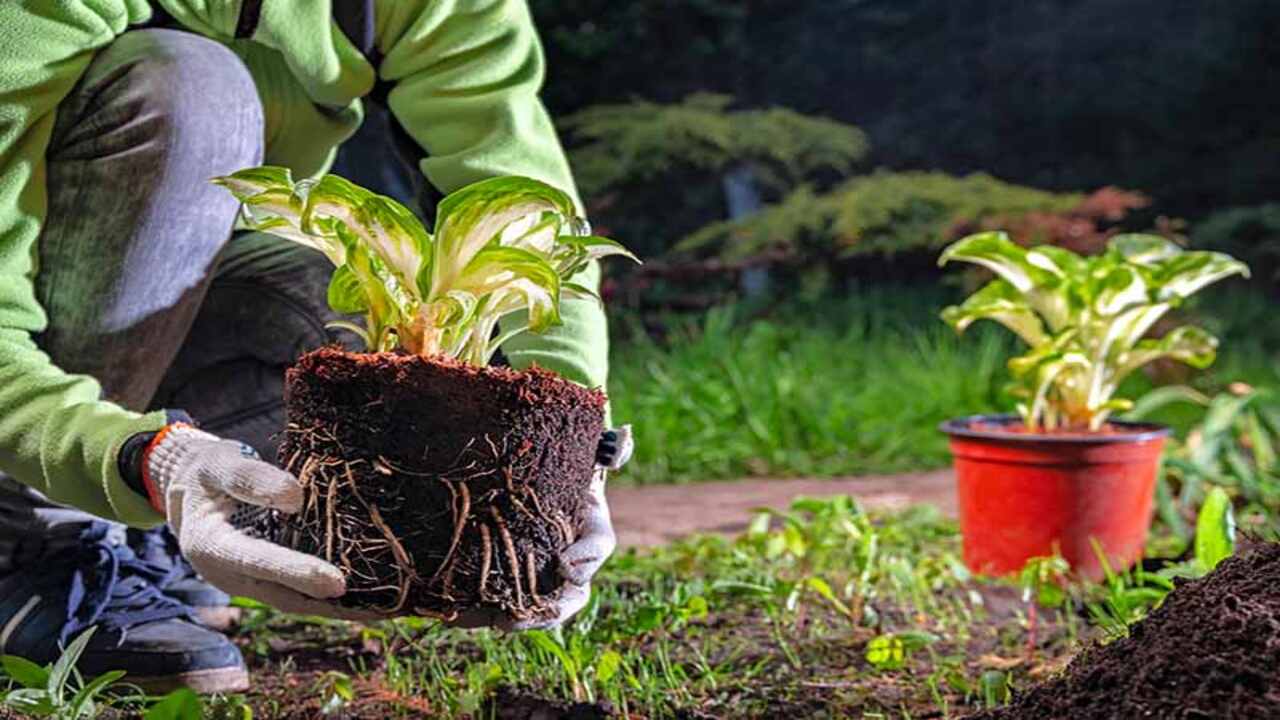
Once you have successfully planted your hostas in pots, providing them with the right care and attention is crucial to promote optimal growth. Regular watering is key, as hostas prefer consistently moist soil. However, it is important to avoid overwatering, as this can lead to root rot. To maintain moisture levels, consider using a self-watering system or adding a layer of mulch around the base of the plant.
- Escolha O Vaso Certo: Certifique-se de escolher um vaso grande o suficiente para acomodar o crescimento das hostas. Elas têm raízes extensas, então um vaso profundo e largo é ideal.
- Solo Adequado: Use uma mistura de solo bem drenado e rico em matéria orgânica. Isso ajudará no crescimento saudável das hostas em vasos.
- Rega Adequada: As hostas em vasos precisam de rega regular para manter o solo úmido, mas não encharcado. Verifique a umidade do solo regularmente e regue conforme necessário.
- Fertilização: Hostas em vasos se beneficiam de fertilizantes de liberação lenta
What Pests And Diseases Do Hostas Have?
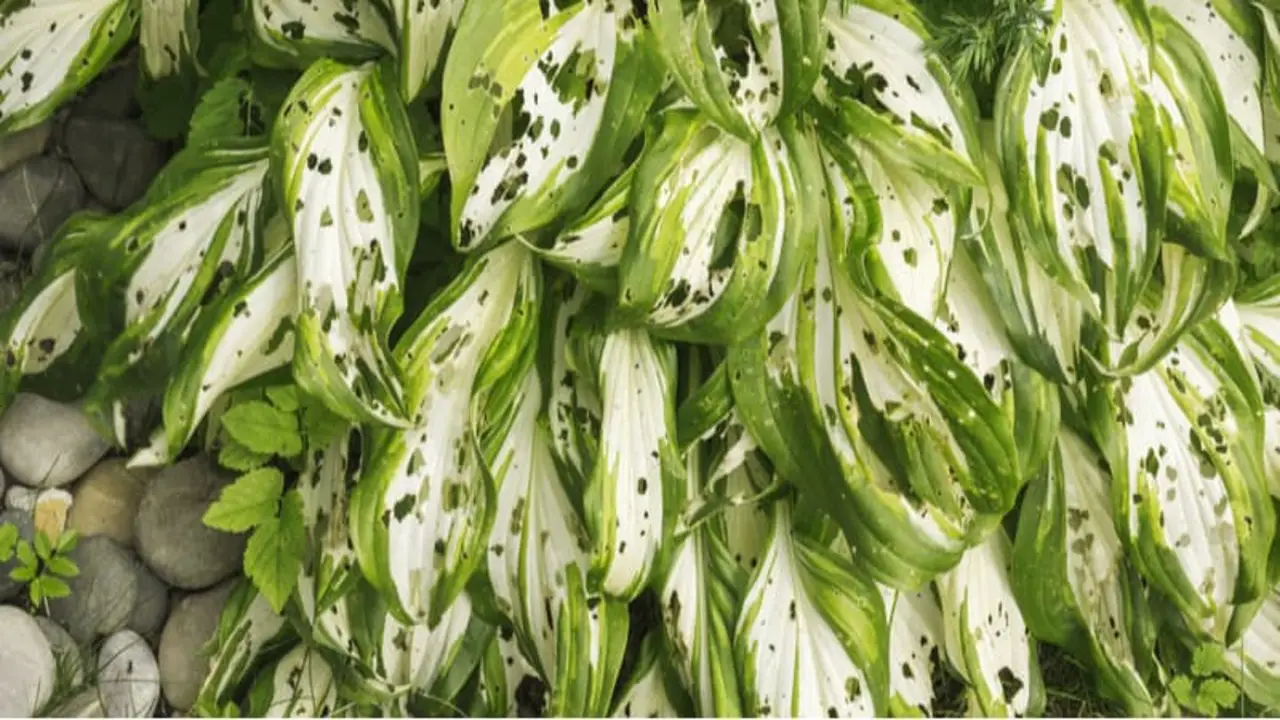
Hostas grown in pots can be susceptible to various pests and diseases. Some common pests affecting hostas include slugs, snails, aphids, and nematodes. These pests can feed on the leaves and cause damage to the plant. To control them, you can use organic methods such as handpicking, diatomaceous earth, or insecticidal soaps.
Hostas can also be prone to certain diseases. One of the most common diseases is hosta virus X (HVX), which can cause discolored or distorted foliage. Purchasing hostas from reputable sources is important to minimize the risk of introducing this virus.
Other diseases that can affect hostas include fungal infections like crown rot, leaf spot, and powdery mildew. To prevent diseases, ensure proper air circulation, avoid overcrowding plants, and water hostas at the base to keep the foliage dry.
Conclusion
growing hostas in pots is a great option for those with limited garden space or those who want to add some greenery to their patio or balcony. Not only do hostas thrive in containers, but they also provide a stunning display with their lush, vibrant foliage.
To start growing hostas in pots, choose a container that is at least 12 inches deep and wide, ensuring there are drainage holes at the bottom. Select a potting mix that is well-draining and rich in organic matter. Following the tips and techniques discussed in this post, you can grow and care for hostas in pots.
With their beautiful foliage and low maintenance requirements, hostas are a wonderful addition to any container garden. So why not bring some life and color to your outdoor space with potted hostas? We hope now you understand how to grow hostas in pots.
FAQ
1.What Are The Key Factors To Consider When Choosing A Pot For Growing Hostas?
Ans: When choosing a pot for growing hostas, it is important to consider factors such as size, drainage, material, and aesthetics. Hostas have extensive root systems, so a pot with a sufficient size to accommodate their growth is essential. Good drainage is crucial to prevent waterlogged soil, so selecting a pot with drainage holes or using a potting mix that promotes good drainage is important.
2.How Often Should Hostas In Pots Be Watered?
Ans: Hostas in pots should be watered regularly, ideally every 2-3 days or when the top inch of soil feels dry. However, adjusting watering frequency based on weather, pot size, and soil drainage is important. Overwatering can lead to root rot, so watering deeply but less frequently is better, allowing the soil to dry out slightly between waterings.
3.Are There Any Specific Soil Requirements For Growing Hostas In Pots?
Ans: Hostas are generally adaptable and can thrive in a variety of soil conditions. However, it is recommended to use a well-draining soil mix rich in organic matter when growing hostas in pots. This helps prevent waterlogged conditions and allows the roots to breathe.
4.Can Hostas In Pots Be Placed In Full Sun?
Ans: Yes, hostas in pots can be placed in full sun, but they may require extra care and attention to prevent them from drying out. Hostas are shade-loving plants, so they prefer partial or filtered sunlight. When placing hostas in pots in full sun, monitoring soil moisture levels and providing regular watering to keep the roots hydrated is important.
5.What Are Some Common Pests?
Ans: Some common pests include insects like ants, cockroaches, termites, mosquitoes, bed bugs, and rodents like mice and rats. Other pests may include spiders, fleas, ticks, and wasps. These pests can cause property damage, spread diseases, and be a nuisance to humans.

